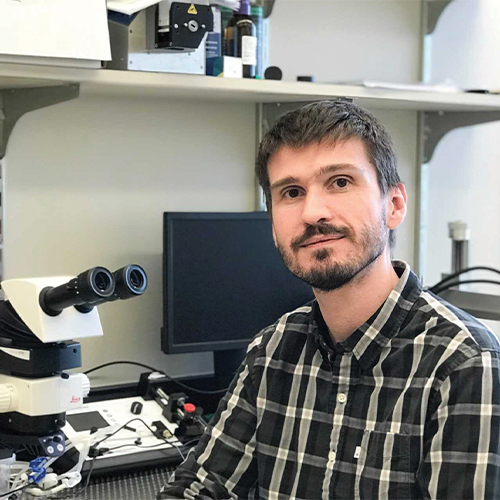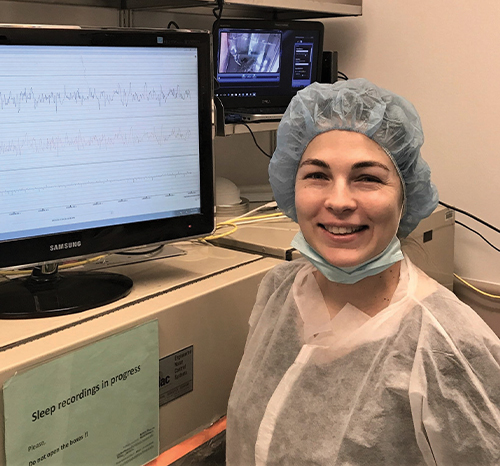For many medical conditions, clinicians can collect quantitative indicators of disease, such as heart rate, body temperature, or levels of a specific protein in a blood sample. For chronic pain, however, such biological markers have not yet been identified. This information gap occurs even though chronic pain is one of the most common reasons why adults seek medical care [1]. If they could be identified, biological markers (or “biomarkers”) for chronic pain could improve patient care by giving doctors a more complete picture of a particular patient’s condition.
“I think biomarkers would allow us to better differentiate different pathologies that chronic pain patients have,” says Richard Harris, Ph.D., professor of anesthesiology with the Chronic Pain and Fatigue Research Center, University of Michigan Medical School (Figure 1). “Another useful thing that biomarkers can do is they can guide treatment for those pathologies. A biomarker might be able to predict whether a given patient may respond to one type of therapy versus another type of therapy.”
Biomarkers could also be useful for preclinical research and developing new treatments for chronic pain. “It’s actually one of the holy grails for pain researchers to get a biomarker for pain, because at this moment we don’t have any,” says Alban Latremoliere, Ph.D., assistant professor of neurosurgery at the Johns Hopkins University (Figure 2). “The way we measure pain is going to be extremely subjective, which is very unfortunate because pain by itself is a subjective sensation, but we don’t have at this stage any quantifiable readouts for pain, any type of pain. That is true in humans, and it’s even more true in animals.”
The way pain is typically assessed in animal studies is by measuring reflexes like paw withdrawal. However, not every type of pain results in a reflex, and these measurements do not provide granular information about pain levels and how they change in response to treatment.
“It’s a very loose way of reading. We know there is pain, but then we cannot really know to which extent an experimental treatment is likely to work,” he says. “That’s been one of the possible reasons why development of new analgesics has been mostly a failure over the last 30 years.”

For these reasons, discovering and validating pain biomarkers is a priority for the U.S. National Institutes of Health’s Helping to End Addiction Long-Term (HEAL) Initiative, a multibillion dollar research initiative that was launched in 2018 to find scientific solutions for the opioid crisis [2]. Three years later, research into pain biomarkers is still at an early stage, but there are promising studies underway [3].

Studying pain with brain imaging
Functional magnetic resonance imaging (fMRI) studies point to differences in connectivity—how well different areas of the brain are connected to one another—as being potential biomarkers for chronic pain. A study of patients with new back pain found brain connectivity differences could predict which patients would have their pain persist over the next year [4]. A retrospective study by Harris’s group found that children who would go on to develop multi-site pain had stronger connections between a brain area called the insula, a part of the limbic system, and a distributed network of brain connections called the default mode network [5]. “What was really remarkable was that we were able to see that pathology before these kids develop their pain,” says Harris.
Hypothetically, being able to identify which people are at risk of developing chronic pain—particularly after acute injury—could one day lead to preventative measures. “If we could identify individuals that might be more vulnerable to developing chronic multi-site pain, you could definitely instruct them to not do things that end up affecting their pain,” says Harris. He cites sleep as an example, since poor sleep is a key predictor of certain types of pain.
A related potential use for neuroimaging biomarkers for pain is being able to predict which drugs and other therapies are more likely to help a particular pain patient. In a small double-blind pilot study of 28 patients with fibromyalgia, Harris and colleagues used functional connectivity fMRI scans to successfully predict which patients would respond to two different pain medications, milnacipran and pregabalin [6]. Harris notes that these results need to be validated by future studies with larger sample sizes.
Now Harris is working on a much larger HEAL-funded study of hundreds of patients with low back pain. This study will use neuroimaging to predict which patients will respond to the drug duloxetine. “What’s interesting in this study is we’re not going to take duloxetine head-to-head with another drug,” says Harris. “We’re going to take duloxetine versus other nonpharmacologic therapies like mindfulness-based stress reduction, acupressure, physical therapy, and other interventions to try to see if we can use the imaging to better guide which patients are likely to benefit from which treatment.”
Neuroimaging will hopefully also provide insight into the types of pain afflicting the back-pain patients. In particular, Harris is interested in identifying which patients have nociplastic pain, which is a type of pain that results from altered central neurobiological function. Patients with fibromyalgia largely have pain resulting from nociplastic processes, whereas chronic back pain patients are often more mixed.
“Some of them, we’re proposing, have central factors whereas others have more peripheral drivers for their pain such as disk herniations or pinched nerves in the back that are driving their pain,” says Harris. “Our hypothesis is that centrally acting treatments like duloxetine and maybe mindfulness-based stress reduction might act more to help individuals that have nociplastic pain, because that’s pain that’s resulting from altered central neural activity.” In contrast, he predicts that patients that have more peripheral pathology, such as back pain that is related to issues with the nerves in the back, may respond better to physical therapy.
For Harris, the future of neuroimaging biomarkers for pain relies on large-scale collaborations. “What I’m hoping is that with these larger studies that involve thousands upon thousands of patients we might be able to get a better handle on the underlying mechanisms that are really driving pain,” Harris says.
Sleep and pain
Using recent advances in neuroscience techniques, Latremoliere and collaborator Chloe Alexandre, Ph.D., instructor of neurosurgery at Johns Hopkins University (Figure 3) are studying the complicated interplay between sleep and pain. Latremoliere says tools like optogenetics—which uses light to activate specific neurons in genetically-engineered mice—have revolutionized pain research. “It’s been really a fantastic time to study pain circuits because we can now start dissecting out specific pathways,” he says.
In one study using optogenetics, the researchers were able to briefly shine a light on a mouse’s hindpaw, which activated specific nociceptors—sensory neurons that normally respond to stimuli that could hurt an animal—and provoked a withdrawal reflex [7]. A similar protocol can be used with sleeping mice implanted with electrodes for electroencephalogram (EEG) recordings. These EEG recordings can provide a readout of when nociceptive neurons fire, a readout that is cleaner and easier to interpret in sleeping mice than in mice who are awake.
“Sleep is its own active process, but at least it’s a process that is defined by being fairly disconnected from the environment,” he says. “We have the hope that this process is fairly consistent and not too noisy and then when we cause pain, or any type of stimulus, we can more precisely study the direct effect on the EEG.”
Latremoliere is cautious to add that the EEG readout is not a measure of pain per se.

“It’s important to make this distinction between nociception and pain in the sense that pain is a very complex phenomenon that is not just a response to activation of nociceptors when we’re about to injure ourselves,” he says. “What defines pain is this very integrated sensation that also has to take into account the backgrounds, cultural changes, and how we perceive it.” However, by quantifying the extent to which a nociceptive pathway is active, EEG recordings during sleep may one day be useful for testing potential therapeutics for pain in preclinical studies.
The researchers are now studying how different types of chronic pain affect sleep. “We found that specific chronic pain models cause very distinct changes in sleep architecture,” says Latremoliere. Understanding more about the interactions between sleep and pain will hopefully also help pain patients who often struggle with sleep. “We know sleep is a major problem for a lot of patients with chronic pain, but it’s not really been addressed to know the nature of the problem and how we can solve it,” he says.
For example, people with rheumatoid arthritis show activation of the nociceptive fibers that send pain signals to the brain. “They do affect sleep, presumably, and so we’re thinking that this marker here could be extremely helpful to quantify the amount of sleep problems due to the activation of receptors,” he says.

Loss of sleep can cause a vicious cycle for people with pain because sleep loss can also increase pain sensitivity [8]. “The interaction can work both ways, but it’s not systematic. Not every type of pain or painful symptom is going to affect sleep the same way and not all sleep problems are going to increase pain,” Latremoliere says. “What we’re trying to do is untangle which one comes first. The simplest question is the hardest to answer.”
Epigenetic changes in pain
Bertrand Léger, Ph.D., head of research at the Clinique Romande de Réadaptation, Sion, Switzerland, works at a rehabilitation center that serves mostly younger patients—with an average age between 40–45—who suffer from chronic pain, often resulting from an accident (Figure 4). “When they come to our place, it’s really, I would say, the last chance therapy,” says Léger. Léger’s group is working to learn more about the biological changes that lead to chronic pain in these patients and to see whether patients with different types of pain have different biological signatures.
“The theory now is that in the brain you have modification at the cellular level that integrates this pain and makes it more central than peripheral,” says Léger. “Because after one year the tissue is repaired; it’s no longer a problem there. It’s something that changed in the brain.”
Léger and his group are among researchers working to determine whether epigenetic changes—changes in gene expression that are not attributed to changes in the underlying DNA—are observable signatures of different forms of pain [9]. In a recent study, conducted in collaboration with Ariane Paoloni-Giacobino, professor of genetic medicine at the University of Geneva, Léger compared the DNA methylation status of genes—an epigenetic process that can change gene expression—in blood samples from 20 healthy people, 18 patients with chronic nociceptive pain, and 19 patients with chronic neuropathic pain [10].
While nociceptive pain is caused by activating pain receptors at the end of nerve fibers either in the skin or deeper within the body, neuropathic pain is caused by alterations to the central or peripheral nervous system. This was the first study to do a whole genome methylation analysis on samples from patients with neuropathic pain. “It’s something that was really developed in the last few years; before, it was impossible,” says Léger.
When Paoloni-Giacobino analyzed the epigenetic data, a stark pattern emerged. The neuropathic pain patients showed epigenetic changes in genes linked to GABA, a neurotransmitter found in the central nervous system that is known to play a key role in the development and maintenance of neuropathic pain. In the nociceptive pain patients, epigenetic changes were found in genes that are part of the opioid analgesic system and genes involved in inflammation. “Ariane [Paoloni-Giacobino] was really surprised to see that two different models of pain can have two different signatures,” says Léger. “And this is important because you don’t treat neuropathic pain and nociceptive pain the same way.”
The fact that the epigenetic signatures for neuropathic and nociceptive pain were so readily distinguishable may suggest that these changes could be used as biomarkers to aid in diagnosis. Right now the gold standard in differentiating between the two is a questionnaire. “[The questionnaire is] really, really, really subjective so there’s room for developing new biomarkers for the type of pain,” says Léger, although he cautions that the results are still very preliminary—especially since the epigenetic signatures were just a snapshot measured at a single period in time.
The next step is a longitudinal study where Léger will follow patients for two years after their initial injury, taking samples and performing clinical assessments throughout to see if epigenetic changes correlate with disease progression. Léger is also tracking epigenetic changes in chronic pain patients treated with noninvasive brain stimulation to see whether recovery from chronic pain reverses the epigenetic changes.
Future for pain biomarkers
Other potential biomarkers under development include different brain imaging techniques, various bioassays, quantitative sensory testing, analysis of pain-related facial movements, and RNA sequencing [3].
In order for any of these biomarkers to reach the clinic, however, they will have to go through a series of validation studies that ensure they are reliable, reproducible, and scalable. For now, the need for improvements in pain diagnostics and pain remains palpable. “I receive a lot of phone calls from people that are really desperate about their pain,” says Léger. “It’s always hard to explain that we are far from the solution.” <
References
- CDC. (2021). Products—Data Briefs—Number 390—November 2020. Accessed: Dec. 17, 2021. [Online]. Available: https://www.cdc.gov/nchs/products/databriefs/db390.htm
- NIH HEAL Initiative. (2021). About. Accessed: Dec. 17, 2021. [Online]. Available: https://heal.nih.gov/about
- K. Davis et al., “Discovery and validation of biomarkers to aid the development of safe and effective pain therapeutics: Challenges and opportunities,” Nature Rev. Neurol., vol. 16, no. 7, pp. 381–400, 2020, doi: 10.1038/s41582-020-0362-2.
- A. Mansour et al., “Brain white matter structural properties predict transition to chronic pain,” Pain, vol. 154, no. 10, pp. 2160–2168, 2013. Accessed: Dec. 17, 2021, doi: 10.1016/j.pain.2013.06.044.
- C. Kaplan et al., “Neurobiological antecedents of multisite pain in children,” Pain, Jul. 2021, doi: 10.1097/j.pain.0000000000002431.
- E. Ichesco et al., “Prediction of differential pharmacologic response in chronic pain using functional neuroimaging biomarkers and a support vector machine algorithm: An exploratory study,” Arthritis Rheumatol., vol. 73, no. 11, pp. 2127–2137, 2021, doi: 10.1002/art.41781.
- L. Browne et al., “Time-resolved fast mammalian behavior reveals the complexity of protective pain responses,” Cell Rep., vol. 20, no. 1, pp. 89–98, 2017. Accessed: Dec. 17, 2021, doi: 10.1016/j.celrep.2017.06.024.
- C. Alexandre et al., “Decreased alertness due to sleep loss increases pain sensitivity in mice,” Nature Med., vol. 23, no. 6, pp. 768–774, 2017, doi: 10.1038/nm.4329.
- A. Polli et al., “Epigenetic and miRNA expression changes in people with pain: A systematic review,” J. Pain, vol. 21, nos. 7–8, pp. 763–780, 2020, doi: 10.1016/j.jpain.2019.12.002.
- L. Stenz et al., “Genome-wide epigenomic analyses in patients with nociceptive and neuropathic chronic pain subtypes reveals alterations in methylation of genes involved in the neuro-musculoskeletal system,” J. Pain, Sep. 2021, Art. No. S1526-5900(21)00332-1, doi: 10.1016/j.jpain.2021.09.001.





